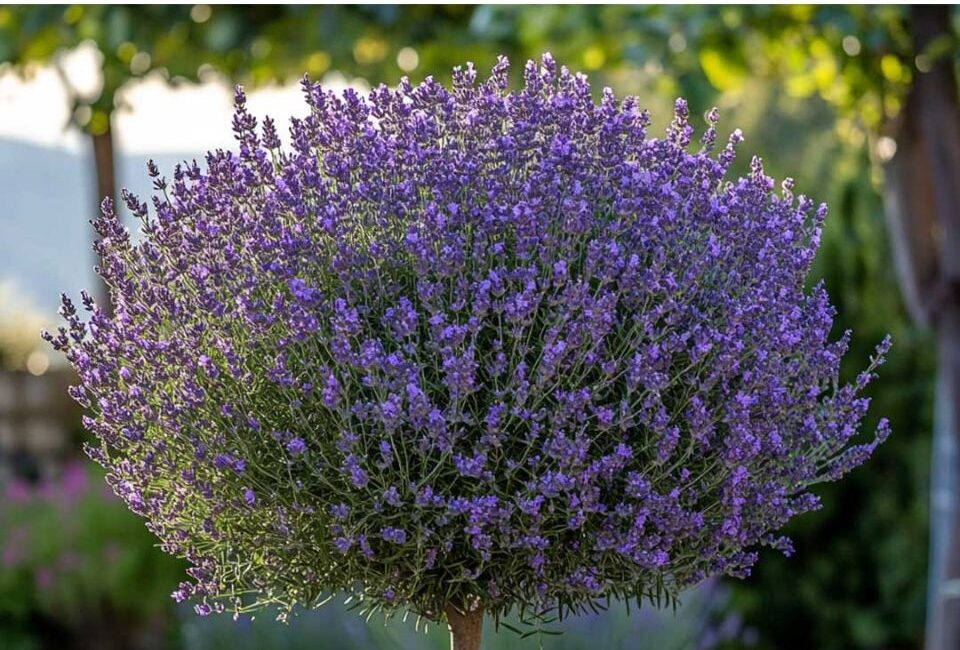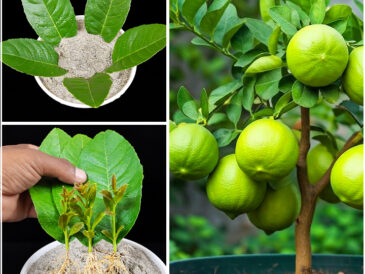- Layer the Pot: Start by placing a layer of small stones or gravel at the bottom of the pot to further ensure good drainage.
- Plant the Lavender: Remove the lavender plant from its nursery pot and gently shake off any excess soil. Dig a hole in the prepared potting mix and place the lavender in it, ensuring that the top of the root ball is level with the surface of the soil.
- Fill and Pack: Fill in around the lavender’s roots with more potting mix, pressing down lightly to eliminate any air pockets.
- Water: Give your lavender a thorough watering to help settle the soil around the roots. However, be careful not to overwater, as lavender does not like wet feet.
Lavender is relatively low-maintenance, but planting it correctly from the start will help ensure it thrives.
6. Caring for Your Lavender Tree: Key Maintenance Tips
Lavender is a hardy plant that requires minimal care once established, but it still needs attention to keep it healthy.
- Watering: Lavender is drought-tolerant and does not need frequent watering. Water the plant thoroughly but allow the soil to dry out between waterings. Be sure to check the soil’s moisture level before watering. During the winter months, watering needs are significantly reduced.
- Light: Lavender requires full sun to thrive. Ideally, it should receive at least 6 hours of direct sunlight per day. Place your pot in a sunny spot, such as a south-facing balcony or patio.
- Temperature: Lavender prefers moderate temperatures and can tolerate hot conditions, but it does not do well in extreme humidity. It can tolerate light frost, but it should be brought inside during freezing weather.
- Air Circulation: Ensure that your lavender has good air circulation to prevent fungal diseases. Avoid placing it in an area where air is stagnant.
7. How to Keep Lavender Blooming Year After Year
Lavender is a perennial plant, meaning it will bloom year after year with proper care. Here are some tips to help your lavender bloom consistently:
- Regular Deadheading: To encourage continuous blooming, remove spent flowers as they fade. This will prevent the plant from putting energy into seed production and encourage new flower spikes.
- Proper Pruning: Prune lavender after each blooming cycle to maintain its shape and prevent it from becoming too woody.
- Avoid Over-Fertilizing: Lavender prefers low-nutrient conditions, so avoid excessive fertilization. Too much fertilizer can lead to lush, green growth at the expense of flowers.
8. Common Problems and Solutions
While lavender is generally easy to grow, it can still face a few common issues. Here are some problems you may encounter and how to address them:
- Root Rot: This occurs when the plant is overwatered or the soil doesn’t drain well. To prevent root rot, ensure the pot has proper drainage and avoid overwatering.
- Leggy Growth: If your lavender becomes leggy and spindly, it may be due to insufficient sunlight. Move the plant to a sunnier location.
- Pests: Lavender is relatively pest-resistant but can occasionally attract aphids or spider mites. Use insecticidal soap or neem oil to treat infestations.
9. Pruning Lavender to Promote Growth
Pruning is essential for maintaining a healthy lavender plant. After flowering, cut back the plant by about one-third to encourage fresh growth and better blooming in the next season. Always use sharp, clean pruning shears to avoid damaging the plant. Avoid cutting into the woody part of the stems, as lavender does not regenerate well from old wood.
10. Harvesting and Using Lavender
Once your lavender has bloomed, you can harvest the flowers to use in various ways. Lavender is perfect for creating aromatic sachets, essential oils, teas, and culinary dishes.
To harvest, cut the flower stems when the buds are still closed but starting to show color. Hang the stems upside down in a cool, dry place to dry out.
11. Overwintering Lavender in a Pot
If you live in
a region with cold winters, you will need to take steps to protect your lavender. While lavender is hardy, it may not survive harsh freezing conditions in a pot. To overwinter lavender:
- Bring the plant indoors or move it to a sheltered area like a garage or greenhouse.
- Reduce watering to prevent root rot.
- Avoid placing the lavender near heating vents, as dry indoor air can harm it.
12. Conclusion: With Patience and Care, Your Lavender Tree Will Thrive
Growing lavender in a pot and having it bloom year after year is not difficult, but it does require attention to detail. By selecting the right variety, pot, and soil, ensuring proper care, and taking steps to protect it during the winter months, you can enjoy the beauty and fragrance of lavender for many years. With time, your lavender tree will reward you with its stunning blooms and soothing aroma, adding a touch of serenity to your home or garden.




